18 Aug 2025

Nestled in the UNESCO-protected Tokaj-Hegyalja wine region of Hungary, the Sauska Tokaj winery blends harmoniously into its surroundings. Its elegant, hovering form appears to float above the vineyards, complementing the landscape while making a striking visual statement. Beyond its architectural beauty, the winery plays a significant role in enhancing the region’s tourism and winemaking prestige.
Tokaj – A historic wine region
The volcanic terrain and continental climate of Tokaj have created ideal conditions for viticulture for centuries, even before the Hungarian Conquest. Villages were established in the valleys, and winemaking took place in cellars carved deep into the volcanic rhyolite tuff. For generations, the region was best known for its legendary aszú, a sweet, oak-aged wine that became a symbol of Tokaj. During the socialist era, mass production overshadowed craftsmanship and innovation. However, following the political transition, the region began a new chapter. Since the early 2000s, modern wineries and a growing tourism scene have breathed fresh life into Tokaj, even though infrastructural development is still catching up.
Architectural vision
The Sauska Tokaj winery is driven by a mission to share with the world the vibrant energy, complexity, and remarkable diversity of Tokaj wines. The design challenge was to create a modern, eye-catching winery primarily focused on fresh, dry white wines and sparkling wines. The building also needed to accommodate hospitality and gastronomy, transforming it into a true visitor destination. The location—an elevated site amidst the most significant settlements of the wine region—provided both inspiration and challenge.
Design philosophy
“…What I create should not touch the untouchable - it should float or sit, like a sphere on an unidentifiably tiny surface. The goal is to create a seemingly implausible structure, one that is there, yet physically independent of its surrounding environment.” – Péter Bordás, architect.
The architectural concept was inspired by the “untouched-untouchable” - the view of undulating vineyards. The aim was to make the building appear like a gentle form floating above the landscape. A beanbag model was made as a humorous presentation that depicted the building mass as if the hill had eyes, bringing the landscape to life.
A floating landmark
Perched atop the southern slopes of Padi Hill, the winery is defined by two intersecting, 36-meter-wide lens-shaped volumes. These visible, elevated structures are freely accessible to visitors, while the functional areas requiring stable temperatures—such as fermentation and storage—are housed underground. In the dramatic, circular fermentation halls on the cellar level, stainless steel tanks are arranged concentrically around a central wooden barrel ageing area. Above this, the restaurant and bar occupy the floating lens structures, supported by slender steel columns. The illusion of levitation is further enhanced by the way sunlight glides across the underside of the hovering forms.
Arrival experience
The entrance is discreetly integrated into the sloping terrain, allowing the sculptural architecture to make an unbroken impact. A wide pathway leads from the parking area, offering breathtaking views of the region’s prized vineyards. Arriving guests step into an intimate transition space that extends into the lobby. From here, a skylit corridor leads to the main visitor areas and the panoramic terrace. Inside, the high, curved ceilings of the restaurant and bar narrow in the direction of the view, drawing the eye outward. As visitors step onto the terrace, the vastness of the landscape unfolds before them, creating a powerful sensory experience.
The interiors of the visitor areas, designed by Tihany Design, draw inspiration from the region’s winemaking traditions. Natural wood surfaces, local limestone cladding, and steel accents create a refined yet welcoming atmosphere. The material palette reflects the essence of the vineyard—timeless, natural, and elegant.
Technological background
The winery’s operational areas—pressing, bottling, and labelling—are arranged in a rectangular layout and connected to the fermentation spaces. Grapes arrive, and finished wines are shipped via a tunnel running along the longitudinal axis of the building. This tunnel also houses essential mechanical equipment. The cold, metallic aesthetic of the cellar contrasts strikingly with the vibrant, warm-toned visitor spaces floating above.
The Sauska Tokaj winery is more than just a place for winemaking—it is an architectural landmark that celebrates the region’s rich heritage. While embracing modernity. By fusing cutting-edge design with tradition, it stands as a testament to the evolving spirit of Tokaj and its world-renowned wines.
Technical sheet
Project Name: Sauska Tokaj
Location: 3908, Rátka, Padi-hegy
Gross Floor Area: 5,830m2
Years of Design: 2014-2022
Year of Completion: 2024
Client: Sauska and Partner
General Design: BORD Architectural Studio
Head Architect: Péter Bordás
Coordinating Architect: Csilla Kracker
Architect Team: Robert György Benke, Fruzsina Damásdi, Róbert Gulyás, Ágota Melinda Keresztesi-Angi, András Kéki, Balázs Móser, Györgyi Püspöki, Tamás Tolvaj, Kata ZihInterior Design: Tihany Design, Alessia Genova, Principal and Adam D. Tihany, Founder, Mechanical Engineering: BORD HVAC Engineering, Zoltán Hollókövi, Structural Design: Hydrastat Engineering, Zsigmond Dezs?
Landscape design: Gardenworks, András Kuhn
Expert, contractor: Barry B. Britton
Photo: Hufton + Crow
Video: SoulCase Studio